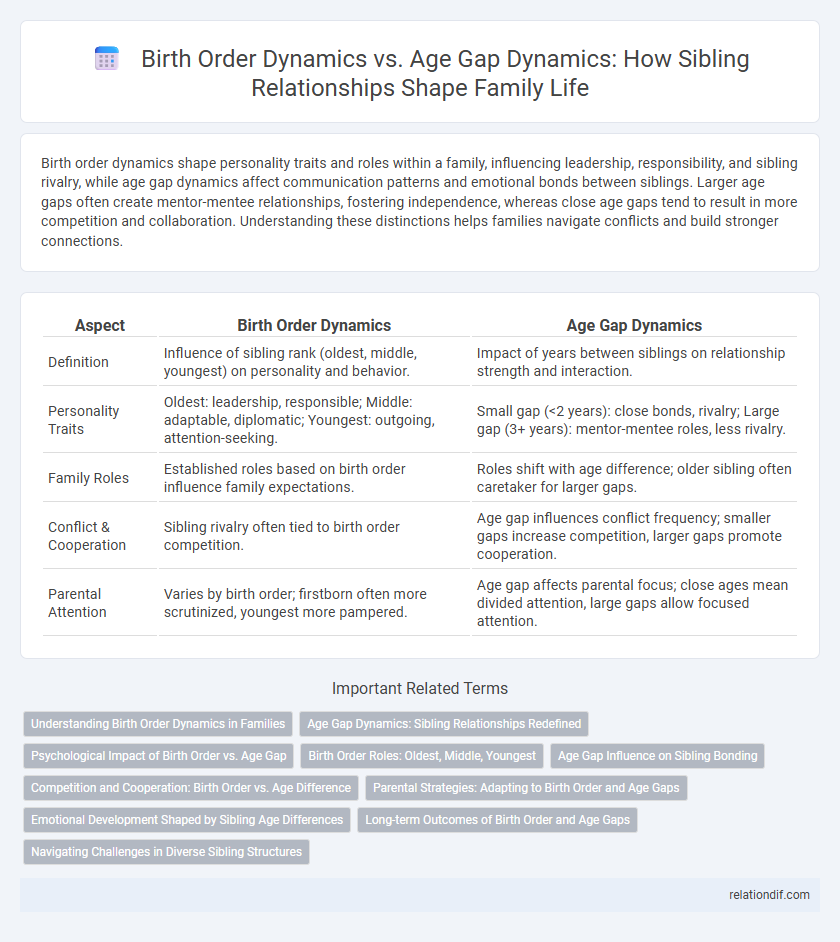Birth order dynamics shape personality traits and roles within a family, influencing leadership, responsibility, and sibling rivalry, while age gap dynamics affect communication patterns and emotional bonds between siblings. Larger age gaps often create mentor-mentee relationships, fostering independence, whereas close age gaps tend to result in more competition and collaboration. Understanding these distinctions helps families navigate conflicts and build stronger connections.
Table of Comparison
| Aspect | Birth Order Dynamics | Age Gap Dynamics |
|---|---|---|
| Definition | Influence of sibling rank (oldest, middle, youngest) on personality and behavior. | Impact of years between siblings on relationship strength and interaction. |
| Personality Traits | Oldest: leadership, responsible; Middle: adaptable, diplomatic; Youngest: outgoing, attention-seeking. | Small gap (<2 years): close bonds, rivalry; Large gap (3+ years): mentor-mentee roles, less rivalry. |
| Family Roles | Established roles based on birth order influence family expectations. | Roles shift with age difference; older sibling often caretaker for larger gaps. |
| Conflict & Cooperation | Sibling rivalry often tied to birth order competition. | Age gap influences conflict frequency; smaller gaps increase competition, larger gaps promote cooperation. |
| Parental Attention | Varies by birth order; firstborn often more scrutinized, youngest more pampered. | Age gap affects parental focus; close ages mean divided attention, large gaps allow focused attention. |
Understanding Birth Order Dynamics in Families
Birth order dynamics significantly influence personality development, sibling relationships, and parental expectations, shaping traits such as leadership in firstborns, independence in middle children, and sociability in youngest siblings. Age gap dynamics further modulate these effects, with larger age gaps often creating mentorship or parental roles among siblings, while smaller gaps promote rivalry and competition. Understanding these intertwined factors helps families foster healthier communication and emotional support systems.
Age Gap Dynamics: Sibling Relationships Redefined
Age gap dynamics significantly influence sibling relationships by reshaping roles and emotional bonds, often fostering mentorship or distant camaraderie depending on the span between siblings. Larger age gaps typically create a parental or guiding role for the elder sibling, leading to unique interactions compared to siblings close in age who often compete or collaborate more directly. Understanding age gap dynamics in families reveals how emotional development and social interactions evolve, redefining traditional sibling roles and connections.
Psychological Impact of Birth Order vs. Age Gap
Birth order significantly influences personality traits, with firstborns often exhibiting leadership qualities and younger siblings displaying greater social adaptability, while age gap impacts sibling relationships by affecting emotional closeness and rivalry intensity. Psychological studies reveal that smaller age gaps heighten competition and comparison among siblings, whereas larger gaps promote mentorship roles and emotional support. The interplay between birth order and age gap shapes individual identity development and sibling bonding across family dynamics.
Birth Order Roles: Oldest, Middle, Youngest
Birth order roles shape personality traits, with oldest children often assuming leadership and responsibility, middle children typically developing negotiation skills and independence, and youngest siblings frequently receiving more attention and exhibiting sociability. Age gap dynamics influence these roles by affecting sibling interactions, where larger gaps can lead to mentorship-like relationships, while smaller gaps may result in rivalry or closer companionship. Understanding both birth order and age gaps helps explain familial behavior patterns and individual development within the family system.
Age Gap Influence on Sibling Bonding
Age gap significantly influences sibling bonding by affecting emotional closeness and shared experiences; larger gaps often lead to mentorship roles rather than typical peer-like relationships. Unique developmental stages during key milestones reduce common ground but increase protective behaviors from the older sibling. Research shows siblings with smaller age gaps tend to have more frequent interactions, while wider gaps encourage diverse forms of support and learning.
Competition and Cooperation: Birth Order vs. Age Difference
Birth order significantly influences sibling competition and cooperation, with firstborns often assuming leadership roles and younger siblings vying for parental attention. In contrast, age gap dynamics affect interaction patterns, where larger age differences may reduce rivalry due to differing developmental stages, fostering mentorship instead of competition. Both birth order and age gaps shape family relationships by balancing rivalry and support, altering how siblings cooperate within the household.
Parental Strategies: Adapting to Birth Order and Age Gaps
Parental strategies vary significantly based on birth order and age gap dynamics, with firstborns often receiving more structured guidance and later-born children benefiting from more relaxed parenting styles. Larger age gaps typically lead parents to adjust their approaches, balancing attention between nurturing independence in older siblings and providing close supervision for younger ones. Tailoring parenting to these factors helps optimize sibling relationships and fosters individual development by addressing unique emotional and social needs.
Emotional Development Shaped by Sibling Age Differences
Emotional development in siblings is profoundly influenced by both birth order dynamics and age gap variations, with firstborn children often exhibiting leadership traits and younger siblings developing adaptability through observation. Age gaps affect emotional bonding; smaller gaps tend to foster rivalry and intense companionship, while larger gaps encourage mentoring roles and independent emotional growth. Understanding these nuanced interactions helps parents support tailored emotional growth, promoting healthier family relationships.
Long-term Outcomes of Birth Order and Age Gaps
Long-term outcomes of birth order reveal that firstborns often develop leadership skills and higher academic achievement, while later-born children exhibit greater social adaptability and creativity. Age gap dynamics influence sibling relationships, with larger gaps fostering mentor-like bonds and smaller gaps encouraging peer-like interactions. Both birth order and age gaps significantly shape personality development, emotional intelligence, and career trajectories across the lifespan.
Navigating Challenges in Diverse Sibling Structures
Birth order dynamics significantly influence personality development, with firstborns often assuming leadership roles while later-born children tend to be more social and adaptive. Age gap dynamics also shape sibling relationships, as smaller gaps may result in rivalry and competition, whereas larger gaps often foster mentorship and care-taking behaviors. Navigating challenges in diverse sibling structures requires understanding these nuanced interactions and promoting open communication to strengthen family bonds.
birth order dynamics vs age gap dynamics Infographic

 relationdif.com
relationdif.com